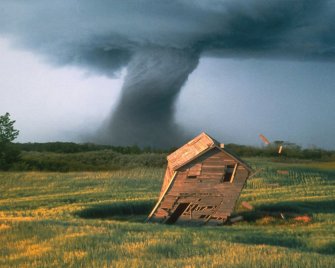What to Know About Tornadoes
Tornadoes are a violent, dangerous, rotating column of air which is in contact with both the surface of the earth and a cumulonimbus cloud or, in rare cases, the base of a cumulus cloud.
They come in many sizes but are typically in the form of a visible condensation funnel, whose narrow end touches the earth and is often encircled by a cloud of debris and dust.
Most have wind speeds between 40 mph (64 km/h) and 110 mph (177 km/h), are approximately 250 feet (75 m) across, and travel a few miles (several kilometers) before dissipating. Some attain wind speeds of more than 300 mph (480 km/h), stretch more than a mile (1.6 km) across, and stay on the ground for dozens of miles (more than 100 km.
They have been observed on every continent except Antarctica, most occur in the United States. They also commonly occur in southern Canada, south-central and eastern Asia, east-central South America, Southern Africa, northwestern and southeast Europe, western and southeastern Australia, and New Zealand.
Multiple vortex is a type in which two or more columns of spinning air rotate around a common center.
Satellite forms very near a large one.
Waterspout is defined by the National Weather Service simply as a twister over water. However, researchers typically distinguish "fair weather" waterspouts from tornadic waterspouts.Landspout (officially known as a dust-tube) though usually weaker than classic twister, they still produce strong winds and may cause serious damage.
Gustnado (gust front twister) is a small, vertical swirl associated with a gust front or downburst.
Dust Devil is a vertical swirling column of air. However, they form under clear skies and are rarely as strong.
Fire Whirl occasionally occur near large, intense wildfires and are called fire whirls.
Steam Devil mainly form from smoke emitting from a power plant smokestack.
Ask Your Tornado and Home Alarm Question HERE!
Return from Tornadoes to Natural Disaster
Back to Home Alarms to Alert You



